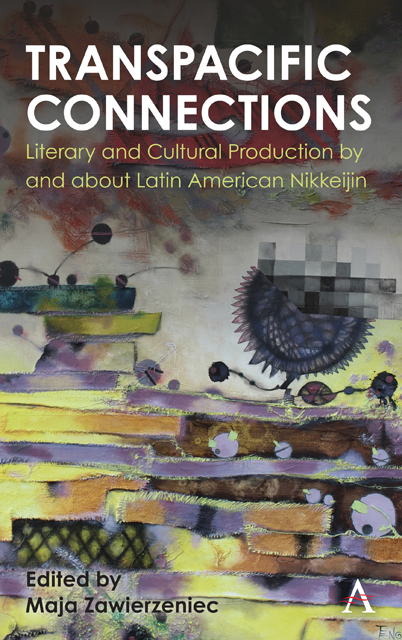Book contents
- Frontmatter
- Contents
- Notes on Contributors
- Introduction
- Chapter 1 The “Japanese Community” in Brazil and its Literary Production: The Functioning of “Death” in Matsui Tarô’s Literary Fiction
- Chapter 2 Contested Modernities: Representations of the Brazilian Dekasegi and the Nipponization of Brazil in Nikkei Cultural Production
- Chapter 3 When Gustave Flaubert Meets Ryūnosuke Akutagawa: “Corazón Sencillo” by Augusto Higa Oshiro. The Short Story of a Peruvian Nikkei Writer
- Chapter 4 Japanese Prints in Tablada’s Writings: Cultural and Media Transposition in ‘El poema de Okusai’
- Chapter 5 The Telenovela Oyuki’s Sin (El Pecado De Oyuki): Las Realidades Del Otro or Mexico through A Japanized Lens
- Index
Chapter 4 - Japanese Prints in Tablada’s Writings: Cultural and Media Transposition in ‘El poema de Okusai’
Published online by Cambridge University Press: 09 December 2022
- Frontmatter
- Contents
- Notes on Contributors
- Introduction
- Chapter 1 The “Japanese Community” in Brazil and its Literary Production: The Functioning of “Death” in Matsui Tarô’s Literary Fiction
- Chapter 2 Contested Modernities: Representations of the Brazilian Dekasegi and the Nipponization of Brazil in Nikkei Cultural Production
- Chapter 3 When Gustave Flaubert Meets Ryūnosuke Akutagawa: “Corazón Sencillo” by Augusto Higa Oshiro. The Short Story of a Peruvian Nikkei Writer
- Chapter 4 Japanese Prints in Tablada’s Writings: Cultural and Media Transposition in ‘El poema de Okusai’
- Chapter 5 The Telenovela Oyuki’s Sin (El Pecado De Oyuki): Las Realidades Del Otro or Mexico through A Japanized Lens
- Index
Summary
The Mexican poet, journalist, diplomat, and art critic José Juan Tablada (Coyoacán, 1871–New York, 1945) spent a large part of his life away from his home country. He travelled twice to France. He served in South America as a diplomat in Bogota, Caracas, and Quito. He lived in the United States for many years in the later stages of his life and died in New York. Most importantly, Tablada stayed in Japan in 1900 for six months, a brief period with far-reaching significance in the writer's career. During this brief yet influential period, he worked as a journalist responsible for a series of chronicles about Japanese culture and society in the literary magazine Revista Moderna, and he started a career as one of the most important japonistes – devotee, collector, and critic of Japanese art – of early twentieth-century Mexico.
In his chronicles and art criticism, Tablada demonstrated significant interest towards Japanese visual art, in particular ukiyo-e, the ‘picture of the floating world’, a genre of prints and paintings popular between the seventeenth and the nineteenth century. In 1914, Tablada published the monograph Hiroshigué [sic]: el pintor de la nieve y de la lluvia, de la noche y de la luna, the first book to introduce Japanese art to Latin America, which includes a thorough introduction to the great ukiyo-e master Utagawa Hiroshige (1797–1858). The book Hiroshigué, as well as most of Tablada's other writings about Japanese art, was inspired and profoundly influenced by earlier French japonistes. With the first page stating ‘a la venerada memoria de Edmundo de Goncourt’, Hiroshigué was supposed to be the continuation of the unfinished series of biographies of ukiyo-e masters by French japoniste Edmund de Goncourt (1822–1896), Outamaro: Le peintre des maisons vertes (1891), and Hokusai: L’art japonais au XVIIe siècle (1896):
Hace mucho tiempo, al acabar de leer el libro Outamaro de Edmundo de Goncourt, me hice el propósito de escribir, para cuando mis estudios artísticos madurasen, un libro semejante […]
[…]
Edmundo de Goncourt, después de Outamaro, sólo alcanzó a escribir Hokusai; pero Hiroshigué estaba en la lista de los cinco pintores.
Ahora yo, en este remoto rincón del planeta que tal vez ni sospechó el maestro dilecto, recojo su designio trunco y trato de realizarlo en parte, como un hijo amantísimo cumpliría la póstuma voluntad de un padre venerado.
- Type
- Chapter
- Information
- Transpacific ConnectionsLiterary and Cultural Production by and about Latin American Nikkeijin, pp. 65 - 80Publisher: Anthem PressPrint publication year: 2022



